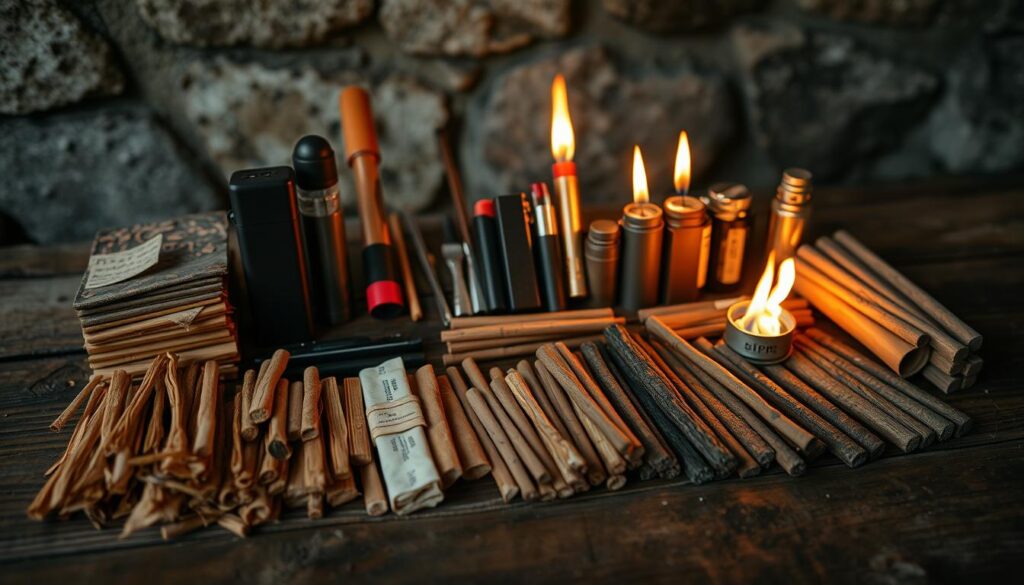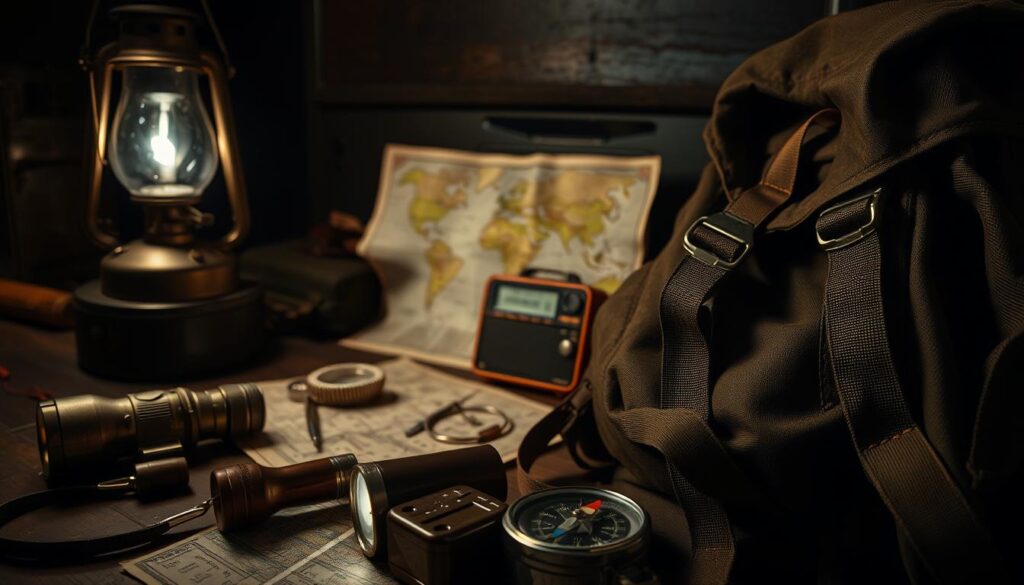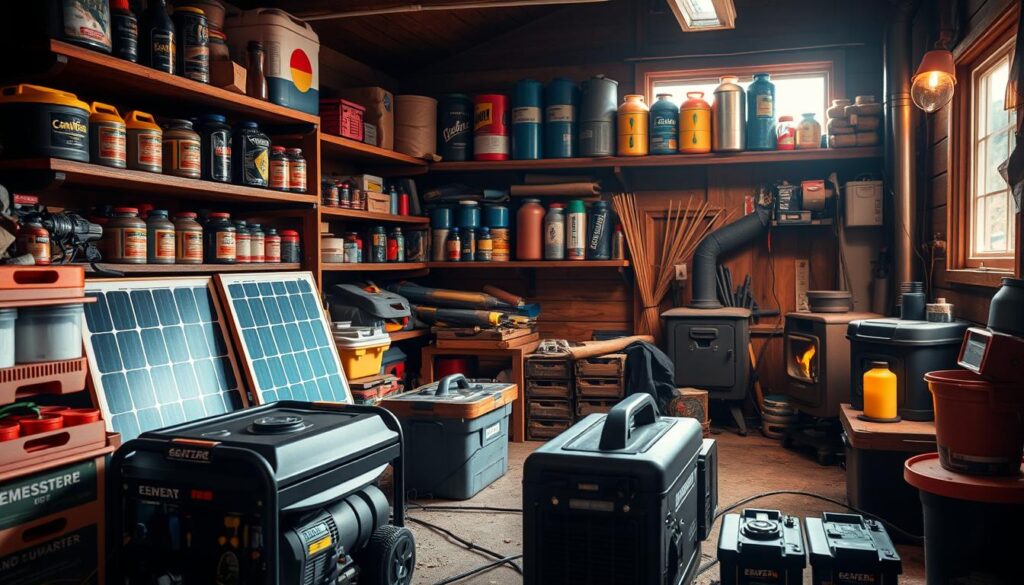As an outdoor lover, I’ve faced the challenge of starting a fire without the right tools. It’s essential for camping, survival, or just a cozy evening by the fireplace. The right fire starters can make a huge difference.
I’ve found that the right fire starting tools can make it easier and safer. In this guide, I’ll show you different methods and fire lighting devices. We’ll cover their types, how to use them, and safety tips.
Key Takeaways
- Understanding the different types of fire lighting devices available
- Learning how to use fire starters safely and effectively
- Discovering the best fire starting tools for various situations
- Mastering safety precautions when working with fire
- Exploring the benefits of using fire lighting devices
Understanding Fire Lighting Devices
Fire lighting devices are key for anyone exploring the wilderness. They provide warmth, a way to cook, and a signal for help in emergencies. These tools are not just gadgets; they are vital for survival.
There are many types of fire lighting devices, from simple matches to advanced ferrocerium rods. Each has its own benefits and is best for different situations. Knowing how to use and maintain these devices is essential.
What Are Fire Lighting Devices?
Fire lighting devices, also known as fire starters or fire igniters, create sparks or flames. They are a must-have in any survival kit. They help start fires in various conditions.
These tools range from basic like matches and lighters to more complex ones like flint and steel or ferrocerium rods. The right device depends on personal preference, the environment, and specific needs.
Importance of Fire Lighting Devices in Survival Situations
In survival situations, fire lighting devices are vital. They allow for starting a fire, which is essential for several reasons. Fire gives warmth, a way to cook food, and a method to signal for help. It also boosts morale and provides a sense of security.
The table below highlights the main benefits of using fire lighting devices in survival situations:
| Benefit | Description |
|---|---|
| Warmth | Fire provides warmth, which is vital in cold environments. |
| Cooking | Fire allows for cooking food, making it safer to eat. |
| Signaling | Fire can be used to signal for help, increasing rescue chances. |
As survival tools, fire lighting devices are not just handy; they are essential for wilderness explorers. Learning how to use them effectively is a critical survival skill.
Types of Fire Lighting Devices
There are many ways to light fires, each with its own good points and downsides. The right tool depends on what you like, the situation, and where you are.
Matches: The Classic Choice
Matches are a common and simple way to start fires. They are cheap and straightforward to use. But, they can struggle in windy or rainy weather.
Key benefits of matches:
- Easy to use
- Portable
- No complex maintenance required
Lighters: Convenience at Your Fingertips
Lighters are a favorite for starting fires. They work better in the wind than matches and are easy to hold with one hand.
| Type | Characteristics |
|---|---|
| Disposable Lighters | Convenient, easy to use, and widely available |
| Refillable Lighters | Environmentally friendly, can be refilled multiple times |
Flint and Steel: A Traditional Approach
The flint and steel method has been around for centuries. It takes some skill but works well in all kinds of weather.
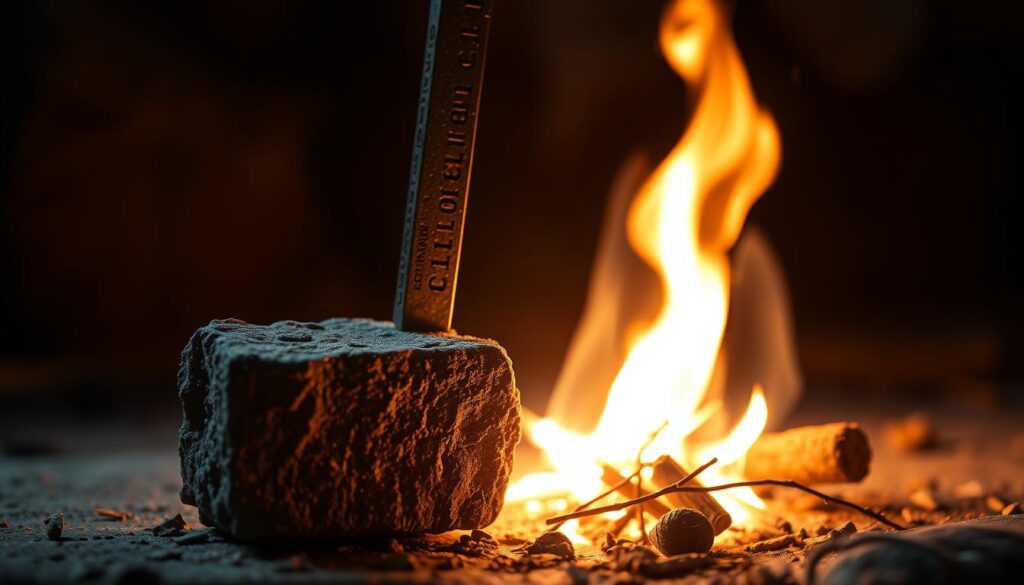
Fire Starters: Modern Innovations
Modern fire starters, like ferrocerium rods, bring new ways to light fires. They are tough, reliable, and make sparks at high temperatures.
Advantages of modern fire starters:
- Highly durable
- Effective in harsh weather conditions
- Easy to use with practice
Choosing the Right Fire Lighting Device
Choosing a fire lighting device needs careful thought. Think about where you’ll use it and what you need. It’s important to consider your environment and personal preferences.
Factors to Consider in Selection
Look at how easy it is to use, how reliable it is, and how long it lasts. A device that’s easy to use and can handle different weather is great for outdoors or emergencies. Also, think about its weight and size, which matters for camping or hiking.
Consider what fuel or material it needs. Some devices need specific fuel, while others work with natural materials. Knowing this helps you make a better choice.
Personal Preferences and Needs
What you like also matters. Some like traditional methods like flint and steel for their simplicity. Others prefer modern tools like lighters for their convenience.
Your choice depends on your needs and where you’ll use it. Whether for camping, emergencies, or daily use, pick something that fits your needs and preferences.
Safety Precautions When Using Fire Lighting Devices
When using fire lighting devices, safety should always be the top priority. Following the right safety precautions can greatly lower the risk of accidents and injuries.
General Fire Safety Tips
To keep a safe environment, follow general fire safety tips. Always keep fires in a safe, controlled area. Use fire pits, fireplaces, or other enclosed spaces for this.
Have a way to quickly put out fires if they get too big. This could be a fire extinguisher, a bucket of sand, or water. Also, watch your surroundings, including the weather and flammable materials nearby.
Specific Precautions for Each Device
Different fire lighting devices need their own safety steps. When using matches, handle them carefully to avoid fires. Make sure lighters are out of children’s reach and used wisely. For flint and steel, be careful of sparks and keep a safe distance from things that can catch fire.
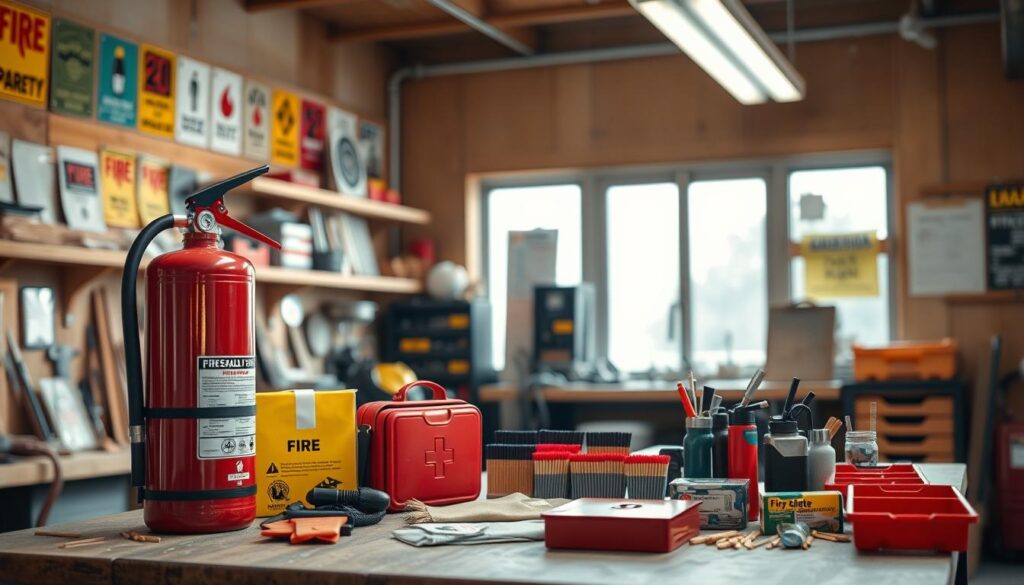
Techniques for Effective Fire Lighting
Learning to light a fire is a key survival skill. It’s important to know how to prepare the fire site and use the right materials. This knowledge can save your life in tough situations.
Preparing Your Fire Site
Start by clearing the area of leaves, twigs, and other flammable materials. This prevents the fire from spreading too far. Choose a safe spot, like a rock or a cleared area, and make a fire ring if needed.
It’s also wise to have water or a fire extinguisher nearby. This way, you can put out the fire if it gets out of control.
Best Practices for Kindling and Fuel
Choosing the right kindling and fuel is key to a successful fire. Begin with tinder like dry leaves or small twigs. Then, add bigger sticks and logs to keep the fire going.
Make sure all your materials are dry. A damp fire won’t start or stay lit. Using a mix of softwoods and hardwoods helps the fire burn well.
Also, arrange the fire to let air flow through. This can be done by making a teepee or crisscross pattern. This helps the fire burn strong and steady.
Using Fire Lighting Devices in Different Environments
Knowing how to use fire lighting devices is key for fun and survival. These tools are great for camping and as survival tools in emergencies.
Camping and Outdoor Adventures
Fire lighting devices are a must for camping and outdoor fun. They light up the campsite, help cook food, and keep you warm. It’s important to pick a device that’s reliable, waterproof, and simple to use.
- Lighters that are windproof and waterproof
- Matches made for outdoor use
- Flint and steel kits for a traditional fire start
For the latest on fire lighting tech, check out Fire Apparatus Magazine. They share the newest in fire lighting technology.
Emergency Situations and Survival Scenarios
In emergencies, fire lighting devices are vital emergency preparedness tools. They help signal for help, keep you warm, and cook food. Choose a device that’s reliable and easy to use, even when stressed.
- Devices that are simple and need little upkeep
- Backup options if your main device breaks
- Learning different fire starting methods
Being ready with the right fire lighting device can greatly improve your survival and comfort in tough spots.
Maintenance and Care for Fire Lighting Devices
Keeping fire lighting devices in good shape is key for outdoor readiness. It makes sure they last longer and work well when needed.
There are a few important steps to maintain these devices. Lighters need refills, while matches must stay dry.
How to Store Your Devices Properly
Storing your fire lighting devices right is the first step. Moisture is a big problem, so they need to stay dry. Keep them in a waterproof container or bag.
For matches, a dry spot is essential to avoid getting damp or wet. Lighters should have their fuel checked often and refilled when low. Store them in a cool, dry spot, away from sunlight.
| Device Type | Storage Tip | Maintenance Tip |
|---|---|---|
| Matches | Keep in a dry, waterproof container | Check for dampness regularly |
| Lighters | Store in a cool, dry place | Refill fuel regularly |
| Flint and Steel | Keep in a protective case | Check for wear on the flint |
Routine Cleaning Tips
Cleaning your devices regularly is also important. For lighters, clean the ignition area for better sparks. For flint and steel, clean the flint and steel to improve sparks.
It’s also key to check your devices often for wear and tear. Look for corrosion on metal parts and make sure everything works right.
By following these tips, your fire lighting devices will always be ready. Whether for camping, emergencies, or backyard fires, they’ll be ready to go.
Troubleshooting Common Issues with Fire Lighting Devices
Fixing fire lighting devices is more than just solving problems. It’s also about keeping them in top shape. This is key when you really need them.
What to Do When Devices Fail
If a fire lighting device stops working, stay calm and think it through. Here’s what to do:
- Check the fuel level or battery.
- Look for blockages or debris.
- Use the user manual for help.
- Replace any damaged parts.
Regular maintenance can stop many issues. For example, keeping your lighter dry and clean helps it last longer.
Recognizing Signs of Wear and Tear
Knowing when your devices are wearing out is important. This way, you can fix problems before they get worse. Look out for:
- Less performance or efficiency.
- Visible damage like cracks or rust.
- Harder times igniting or keeping a flame.
Early detection means you can fix issues quickly. This keeps your devices working well.
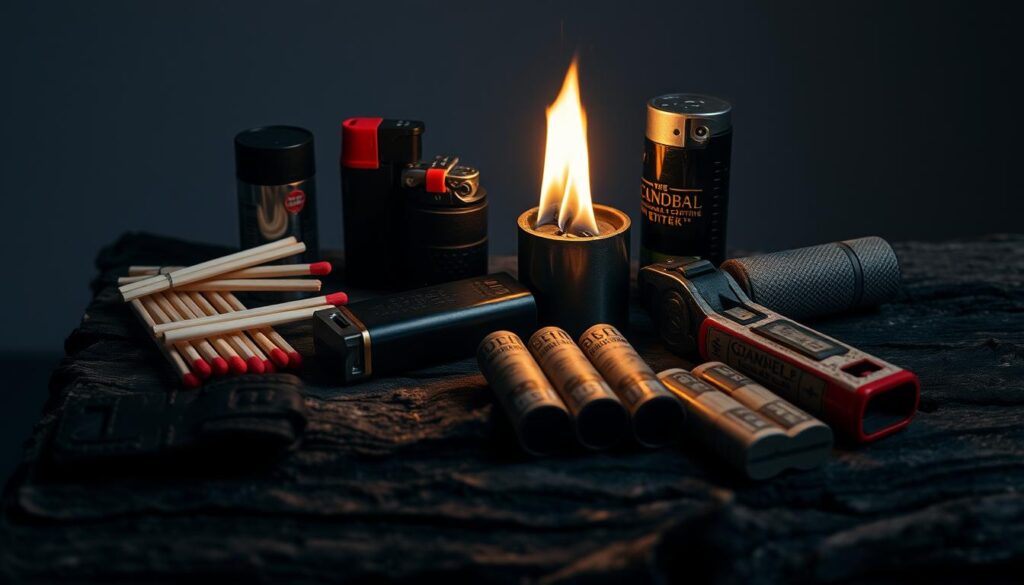
Learning to fix and maintain your fire lighting devices is vital. It’s important for outdoor lovers and anyone who needs these devices for survival.
The Role of Fire Lighting Devices in Everyday Life
Fire lighting devices are not just for the wilderness. They add convenience, warmth, and ambiance to our daily lives. They are not only for survival or outdoor adventures.
Cooking and Heating: Practical Uses
These devices are great for cooking and heating. They help light a barbecue grill, ignite a fireplace, or start a wood-burning stove. Having a reliable fire lighting device makes these tasks easier and safer.
For example, using a lighter or match to light a gas stove or fireplace is simple. But the right device is key, like when your hands are wet or it’s windy. Reliable fire lighting devices make the job easier.
Creating Ambiance at Home
Fire lighting devices also help create ambiance at home. Lighting candles, fireplaces, or outdoor fire pits can make a space look and feel better. The warm glow of candles or the sound of a fireplace can make a place cozy and inviting.
Using these devices for ambiance is more than just functionality. It’s about crafting an experience. Whether it’s a romantic dinner, a family gathering, or a casual evening, the right ambiance can make it special. They let us enjoy the moment without worrying about lighting.
In summary, fire lighting devices are essential in our daily lives. They help with cooking and heating and make our homes warmer and more inviting.
My Experiences with Fire Lighting Devices
I’ve learned a lot from using fire lighting devices. I’ve tried them out in many situations, like camping and emergency drills. These experiences showed me how important it is to have a reliable fire starter. They also taught me how to use them well.
Key Lessons Learned
Practicing is key. Just owning a fire starter isn’t enough. You need to practice using it in different situations. For example, lighters are easy to use but might not work in wet or windy weather. Flint and steel devices, though harder to use, work better in bad weather.
It’s also important to have a backup plan. I’ve had times when my main fire starter didn’t work, but a backup saved the day. This taught me to always carry more than one starter, when I’m in the wilderness.
| Device Type | Reliability in Harsh Conditions | Ease of Use |
|---|---|---|
| Lighters | Low | High |
| Flint and Steel | High | Low |
| Matches | Medium | Medium |
Tips I Wish I Knew Sooner
Keeping your fire starters in good shape is very important. Regular checks and cleanings can prevent failures. For example, a dry and clean lighter will work better when you need it.
Also, know your environment. Different places need different fire starting strategies. In wet places, a waterproof match or ferrocerium rod can be a big help.
Comparing Fire Lighting Devices’ Effectiveness
Spending time outdoors has taught me how vital reliable fire lighting devices are. Whether for survival or a camping trip, starting a fire quickly is key. It greatly impacts your experience.
Performance Under Different Conditions
Fire lighting devices perform differently in various conditions. For example, matches are a traditional choice but fail in wet or windy weather. Lighters are more dependable but can break if not cared for.
Let’s look at how different fire lighting devices do in different weather:
| Device | Dry Conditions | Wet Conditions | Windy Conditions |
|---|---|---|---|
| Matches | Effective | Ineffective | Ineffective |
| Lighters | Very Effective | Effective | Effective |
| Flint and Steel | Effective | Very Effective | Effective |
Cost vs. Benefit Analysis
When picking fire lighting devices, think about cost vs. benefit. High-quality lighters cost more at first but save money over time. They are reliable and last long. For more on survival lighting, check out Mastering Survival Lighting.
Here’s a quick look at cost vs. benefit:
| Device | Initial Cost | Long-term Cost | Effectiveness |
|---|---|---|---|
| Matches | Low | High | Variable |
| Lighters | Moderate | Low | High |
| Flint and Steel | Moderate | Low | High |
Conclusion: Enhancing Your Fire-Lighting Skills
Improving your fire-lighting skills is key for outdoor fun and emergencies. By picking the best fire lighting tools and trying different ways, you’ll get better at starting fires. This makes you more confident and skilled.
Final Thoughts on Choosing and Using Fire Lighting Devices
Choosing the right fire lighting tool depends on what you like, need, and where you’ll use it. Knowing these helps you make a smart choice.
Encouragement to Try Different Methods
I suggest you try different ways to light fires. Use matches, lighters, or old-school methods like flint and steel. The more you practice, the better you’ll get. This way, you’re ready for any situation.
FAQ
What are the most common types of fire lighting devices?
Common fire lighting devices include matches, lighters, and flint and steel. Modern options like ferrocerium rods are also popular.
How do I choose the right fire lighting device for my needs?
Think about ease of use, reliability, and where you’ll use it. Also, consider your personal preferences.
What safety precautions should I take when using fire lighting devices?
Always keep fires contained and have a way to put them out. Know the safety rules for each device, like handling matches carefully.
How do I properly store and maintain my fire lighting devices?
Store them in dry places and clean them as needed. This keeps them working well.
What are some best practices for kindling and fuel when starting a fire?
Choose the right materials and arrange them well for a good fire. This helps it burn well.
Can fire lighting devices be used in different environments, such as camping or emergency situations?
Yes, they’re useful in many situations. This includes camping, outdoor adventures, and emergencies.
How do I troubleshoot common issues with fire lighting devices?
Learn to fix or replace them when needed. Recognize when they’re worn out to keep them working.
Are there any practical applications of fire lighting devices beyond survival situations?
Yes, they’re useful in daily life. For example, in cooking, heating, and setting a cozy mood.
How do different fire lighting devices perform under various conditions, such as wet or windy environments?
Devices like ferrocerium rods work well in wet conditions. But, performance can vary in different weather.
What is the importance of practicing with different fire lighting devices?
Practicing makes you better at starting fires. It’s key for survival skills.
What are some additional fire starting tools that can be used alongside fire lighting devices?
Tools like fire starter kits and kindling tools help start fires. They’re part of fire making supplies.

